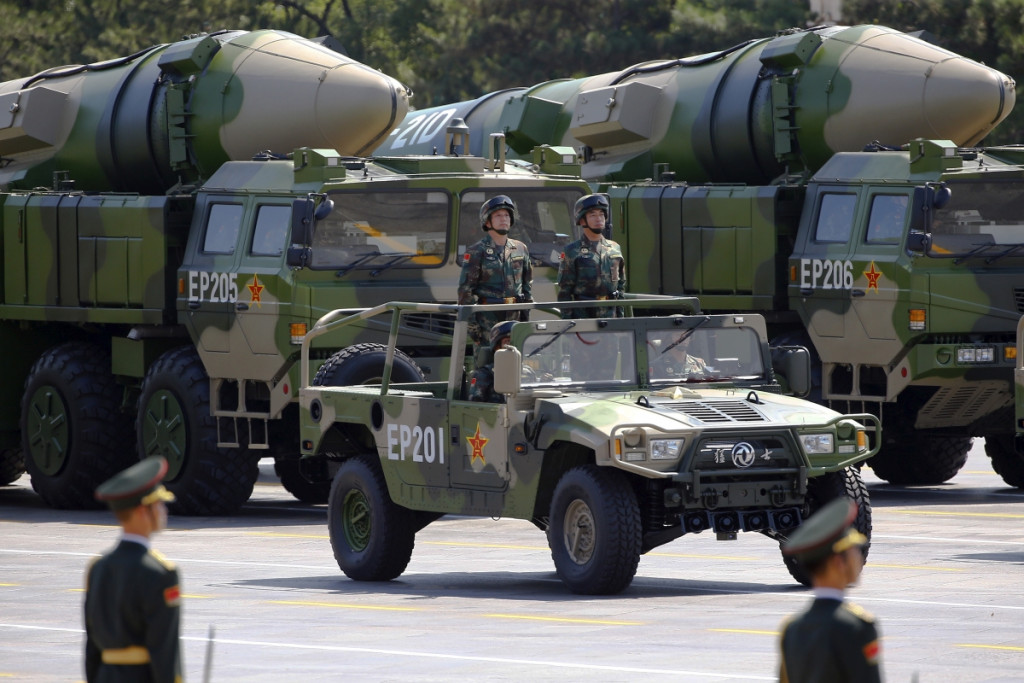Is China sending Washington a message?

Military vehicles carrying DF-21D ballistic missiles roll to Tiananmen Square during a military parade to mark the 70th anniversary of the end of World War Two, in Beijing, ChinaDamir Sagolj/Reuters
Written by Brian Kalman exclusively for SouthFront: Analysis & Intelligence.
Brian Kalman is a management professional in the marine transportation industry. He was an officer in the US Navy for eleven years. He currently resides and works in the Caribbean.
China conducted a test launch of its newest nuclear capable ICBM, the DF-41, on April 12th. The missile was launched from a road-mobile launch vehicle. Two multiple independently targetable reentry vehicles (MIRV) from the launch were tracked by U.S. satellites. Some sources claim that the unarmed MIRVs splashed down somewhere in the South China Sea, but neither Chinese nor U.S. officials will confirm this. In response to questions regarding the impact location of the dummy warheads, the Chinese Defense Ministry cryptically responded that “It is normal for China to execute scientific experiments within its territory, and these experiments are not aimed at any specific country nor target”, admitting only that the missile was test fired “near the South China Sea on April 12.”
China had conducted an earlier DF-41 canister ejection test from a rail-based launcher on December 5th of last year. The DF-41 is designed to be launched from rail-based and road-mobile launchers as opposed to a stationary silo, so as to maximize the difficulty in tracking their location and to improve the chances of their survivability in a first strike. The DF-41, or Dong Feng (East Wind)-41 has an effective range of between 7,500 and 9,300 miles, allowing it to hit any point in the continental United States within 30 minutes from launch. The ICBM is also capable of delivering up to ten MIRVs. The most recent test exhibited the DF-41s ability to deliver at least two MIRVS. China most likely did not test the missile with the maximum MIRV payload, as to keep foreign intelligence services in question as to the exact capacity of the DF-41.

DF-41 on a road-mobile launcher.
China aims to deploy the DF-41 in both a road-mobile and a rail-based variant by 2020, and it appears that the ICBM is in the advanced stages of development. China has made a great deal of progress over the past decade in developing more advanced, MIRV capable ICBMs both for its newly renamed People’s Liberation Army Rocket Force, and People’s Liberation Army Navy nuclear ballistic missile submarine fleet. The Chinese are also developing maneuvering reentry vehicles (MARV) for their ICBMs. These MARVs make the warheads much harder to intercept upon separation from the ICBM and during re-entry. The DF-41 will most likely have MARV capability upon its eventual deployment with the PLA Rocket Force in the coming years.
At a time when Congressional leaders, lobbyists, and military analysts are questioning the age and viability of the U.S. nuclear deterrent, both China and Russia have been quantitatively and qualitatively enhancing their own nuclear capabilities. China has at least 4 Type 094 Jin Class SSBNs in service conducting deterrent patrols, with four additional vessels planned to be built and commissioned by 2020. The Type 094 carries 12 JL-2 submarine launched ballistic missiles (SLBM) that carry 2 to 3 MIRVs each and have an effective range of approximately 4,600 miles.

Two PLAN Type 094 SSBNs.
Russia has similarly made headway in recent years in updating its submarine based nuclear deterrent fleet by fielding 3 out of a planned 8 total Dolgorukiy (NATO designation Borei) Class SSBNs. Otherwise known as the Project 955, the 4th generation SSBN has enough launch cells to accommodate 16 RSM-56 Bulava SLBMs. The Bulava has an effective range of 5,600 miles and can carry 6 to 10 MIRVs. The 5 submarines yet to be completed have been redesigned to accommodate a payload of 20 Bulava SLBMs.

Project 955 Borei Class SSBN.
The Russian RS-24 Yars fifth generation ICBM has been in service since 2010, with 63 road-mobile units and 10 silo based units fielded by January of this year. The Yars has an effective range of 6,800 miles and can carry up to 10 MIRVs. Each warhead is equipped with advanced ABM defeating countermeasures, making it very difficult for anti-ballistic missile systems to target and defeat. Russia plans on replacing all of its older ICBMs with both the RS-24 Yars and the Topol-M.

RS-24 Yars road-mobile launchers on display at the 2015 Victory Day Parade in Moscow.
The more advanced RS-28 Sarmat ICBM is also in the advanced stages of research and development and is slated to replace the SS-18 Satan in the Russian nuclear deterrent arsenal. The RS-28 Sarmat is expected to start undergoing advanced testing this summer, with operational deployment beginning in 2018. Russia is currently developing hypersonic delivery vehicles for the 10 warheads that the RS-28 is designed to carry. Hypersonic MARVs are not only capable of changing trajectory, but also fly at such a high speed that they will be virtually impossible to intercept.
Whether the latest test launch by China of the DF-41 ICBM was meant to send multiple messages to Washington or not is up to interpretation. If it is confirmed that the dummy warheads that splashed down in the South China Sea, just days after U.S. Defense Secretary Ashton Carter visited the USS John C. Stennis CSG in the region on April 16th, the message to the U.S. is quite clear. China is sending the message that they are not only capable and willing to fight the U.S. in China’s back yard, but are quickly obtaining the ability to strike the U.S. in its own back yard.





